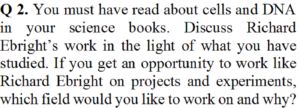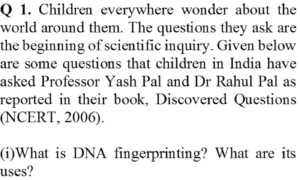English CBSE Class 10 NCERT Footprints Without Feet Chapter 6 The Making of a Scientist Free Solution of Textbook Questions and Answers
THE MAKING OF A SCIENTIST
(Textbook Questions)
Read and find out


Answer: As a child Richard Ebright used to collect butterflies. His mother gave him a book titled ‘The Travels of Monarch X’. This book taught how Monarch X migrate to Central America. The book introduced to him the world of experimenting. It is through experiments that Richard learnt his lessons of science and made many discoveries. Hence the book was the turning point in his life.


Answer: His mother took him to several places. She bought him telescope, microscope cameras and many other equipment. She gave her full company when he was kid. She used to bring his friends to house. She would talk to him on dining table. She gave him works and things to learn if he did not have any work. She gave him the book ‘The Travels of Monarch X’ which proved to be turning point in his life.


Answer: Ebright had displayed slides of tissues of a frog that he showed under a microscope. He did not win any prize. He understood that a neat display of things was not good enough in science. The real meaning of science lay in experimenting. Next year he presented his experiment and won first prize in zoology and third prize overall.


Answer: Ebright conducted an experiment to prove that monarch butterflies try to copy viceroy butterflies to avoid becoming food of birds. Then he tried to find out the purpose of golden spots on the wings of monarch pupa which led to discovery of an insect hormone. He continued his experiments in this area to eventually discover how cells communicate with DNA. This could lead to new ideas about preventing certain types of cancer and other diseases.


Answer: One should be ready to work hard and be competitive in the right sense to learn more. One should have first rate mind (a quick learner), be curious to learn more and have the will to win for right reasons.
Think about it


Answer: Reading books is the first step of learning. But it is not sufficient.
One needs to be highly curious and a quick learner. One would need to be a very good observer. One would need to quickly analyse and logically combine all observations to make a theory. Thereafter a series of experiments needs to be conducted to validate the theory. While conducting experiments care has to be taken to consider all possible variation.
And the most important aspect is that one should be ready to put in hard work to win in right sense.


Answer: A cell is the smallest functional unit of a living body. It is the basic building block of all living things. They provide structure for the body, take nutrients from food, convert nutrients into energy and carry out specialized functions.
DNA is situated in the nucleus of the cell. It is a molecule that holds instruction for making proteins in our bodies. Our behaviour and structure of body is governed through DNA.
Ebright had found out how DNA communicates with a cell for development and growth of body. An understanding of this process can help us to prevent occurrence of several diseases in the human body.
Yes, if an opportunity is given to me, I would like to work on this aspect. Because this is a new field and can help the society to a great extent.
Talk about it


Answer: The sequence base of DNA in each of our cell is same but it is different in any other person. When certain enzymes are added to DNA, it breaks at different places. These fragments move at a certain rate under electric field. The pattern of movement is called fingerprints of DNA.
Since sequence of DNA is different in every individual, fingerprints of DNA is unique to every individual. So identity of a person can be ascertained accurately. This technique can be used in identifying a criminal and remains of a person through DNA mapping of tiny hair, extremely small amount of blood or skin.


Answer: Honeybees secrete a special chemical called pheromone from their body. This has unique smell. This chemical sticks to the honeycomb. Honeybees identify their own honeycomb by the smell of this chemical.


Answer: Rain is the result of condensation of vapour into water. As the vapour cools it is converted into water. Then it becomes heavy and starts falling down. All the vapour in a cloud cannot condense at one time. Therefore rain falls in drops.
****


0 Comments